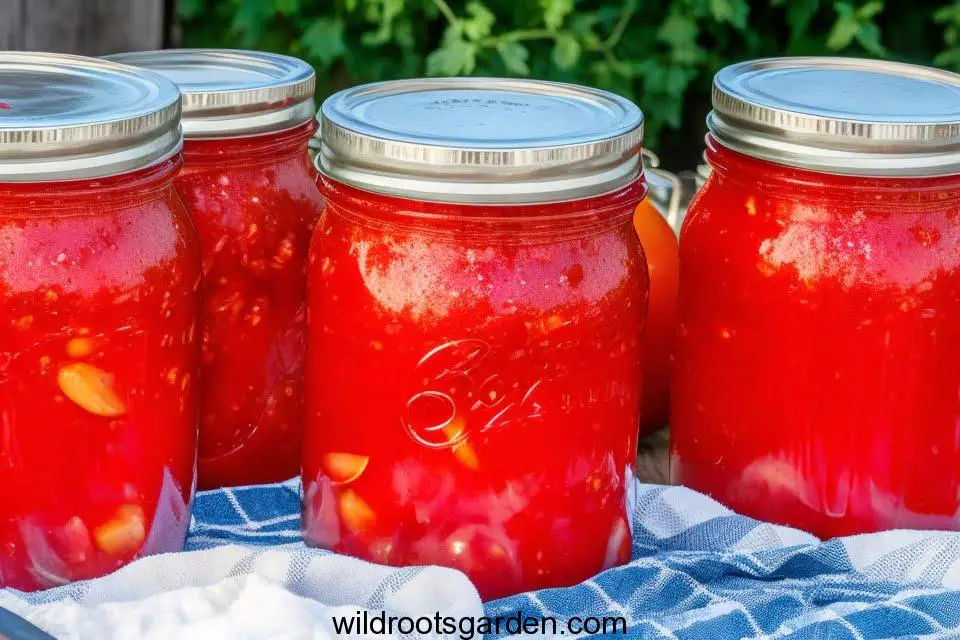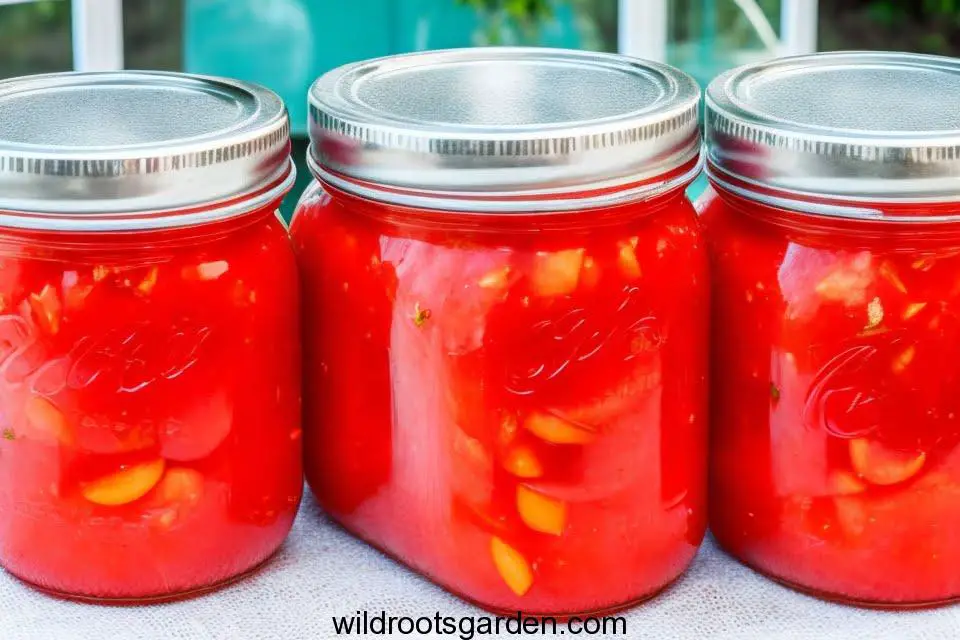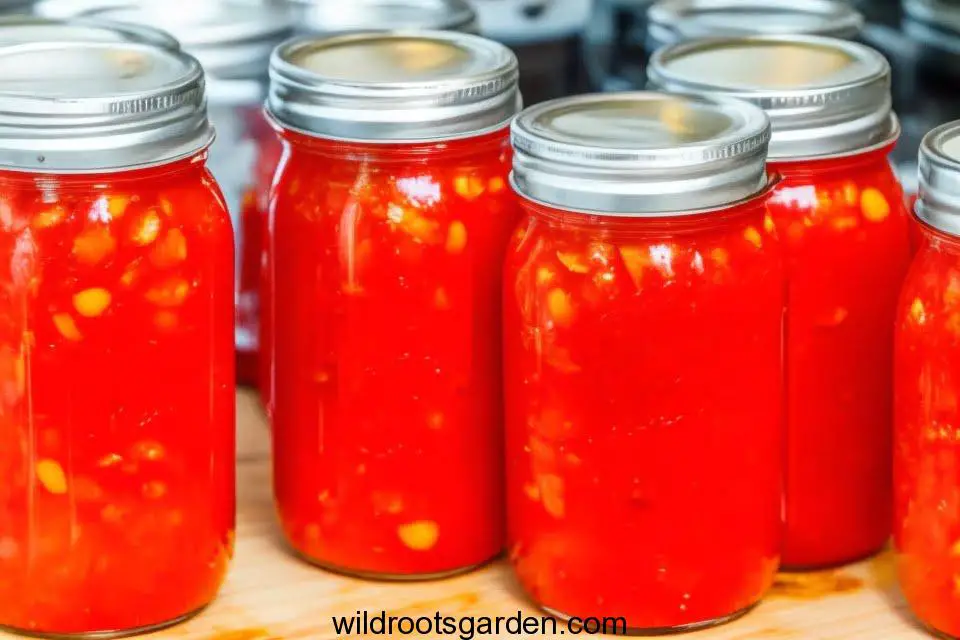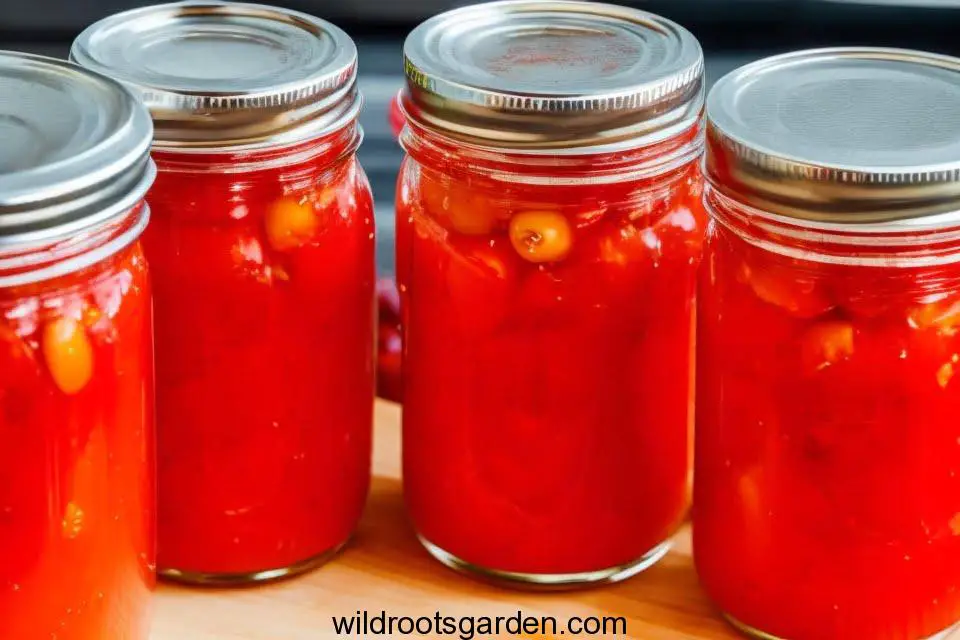Canning Tomatoes Without Lemon Juice. Do you favor keeping the summer tomatoes’ vivid flavors? An excellent method to enjoy the taste of ripe tomatoes all year long is to can tomatoes. Yet, to maintain the amount of acidity required for secure preservation, traditional canning techniques frequently rely on the use of lemon juice. What happens, though, if you’d rather can tomatoes without lemon juice? This in-depth instruction will go through how to can tomatoes without lemon juice, giving you the knowledge and assurance to store these delectable fruits without changing their flavor.

JUMP TO TOPIC
Canning Tomatoes Without Lemon Juice: A Quick Overview
Other techniques must be used when canning tomatoes without lemon juice to assure their safety. While lemon juice is frequently added to boost acidity and stop bacterial growth, you can also use alternative methods to have the same results. You can safely can tomatoes without sacrificing their flavor by following these instructions:
- Choose the right tomatoes: Select fully ripe, high-quality tomatoes for canning. The best varieties for canning are those with a balanced flavor and firm texture, such as Roma, San Marzano, or Amish Paste tomatoes.
- Prepare your jars and lids: Thoroughly wash your canning jars and lids with hot, soapy water. Rinse them well and keep them warm until ready to use.
- Remove the tomato skins: Blanch the tomatoes by immersing them in boiling water for 30 seconds, followed by an immediate transfer to an ice bath. The skins will easily peel off, allowing you to remove them effortlessly.
- Prepare the canning liquid: Instead of using lemon juice, you can use alternative acids to ensure safe preservation. Vinegar, citric acid, or powdered tartaric acid can be used in the recommended proportions to maintain the necessary acidity.
- Pack the jars: Fill the hot, sterilized jars with the blanched tomatoes, leaving a 1/2-inch headspace at the top. Add the prepared canning liquid, leaving the same headspace.
- Remove air bubbles: Gently run a non-metallic utensil around the inside of the jar to remove any trapped air bubbles. This step ensures proper sealing and helps prevent spoilage.
- Seal the jars: Wipe the jar rims with a clean, damp cloth to remove any residue. Place the lids on the jars and screw on the bands until they are finger-tight. Avoid overtightening, as it may prevent air from escaping during the canning process.
- Process the jars: Submerge the filled jars in a boiling water bath canner, ensuring they are fully covered with water. Process according to the recommended time for your altitude and jar size.
- Cool and store: Once the processing time is complete, carefully remove the jars from the canner and place them on a towel-lined countertop. Allow them to cool undisturbed for 12 to 24 hours. After cooling, check the seals and store the jars in a cool, dark place.
Now that we have covered the basic steps, let’s dive deeper into the process of canning tomatoes without lemon juice.

Canning Tomatoes Without Lemon Juice: A Step-by-Step Guide
Step 1: Selecting the Right Tomatoes
It is crucial to select the best kind of tomatoes when canning tomatoes without lemon juice in order to achieve the best results. Use tomatoes that are fully ripe and have a good balance of sweetness and acidity. Overripe tomatoes may become too mushy during the canning process, therefore the texture should be firm. Roma, San Marzano, and Amish Paste tomatoes are the best kind of tomatoes to can.
Step 2: Preparing the Jars and Lids
It is essential to properly prepare your jars and lids before you start canning. Make sure to thoroughly clean the canning jars and lids by washing them in hot, soapy water. Rinse them thoroughly to get rid of any soap traces. Until you are ready to use them, keep the jars and lids warm. This can be accomplished by running them through the “hot dry” cycle of the dishwasher or by keeping them in a warm oven.
Step 3: Removing the Tomato Skins
To readily remove the skins, the tomatoes must first be blanched. Bring a kettle of water to a rolling boil to get things going. The tomatoes should be carefully lowered into the boiling water and blanched for around 30 seconds. Transfer the tomatoes to a bowl of ice water with tongs or a slotted spoon so they can cool quickly. The skins will become looser due to the sudden temperature change, making them simple to peel off.

Step 4: Preparing the Canning Liquid
With conventional canning techniques, lemon juice is added to tomatoes to raise their acidity level, which inhibits the development of hazardous germs. To keep the required pH level, you can choose different acids if you’d rather not use lemon juice. Typical replacements include white vinegar, citric acid, and powdered tartaric acid. To ensure secure preservation, adhere to the suggested ratios listed by reliable canning sites.
Step 5: Packing the Jars
It’s time to pack the jars once the tomatoes have been blanched, peeled, and the canning liquid has been made. The blanched tomatoes should be put into each jar, and carefully pressed down to remove any air bubbles. Each jar should have a 1/2-inch headspace at the top to accommodate expansion during processing. Using the same 1/2-inch headspace, pour the prepared canning liquid into each jar.
Step 6: Removing Air Bubbles
During the packing procedure, air bubbles may become trapped inside the jars and jeopardize the seal. Run a non-metallic object, such as a plastic spatula or a bubble remover tool, around the inside of the jar to get rid of any air bubbles. By doing so, any trapped air will be released, helping to ensure a tight seal.

Step 7: Sealing the Jars
To get rid of any leftovers or food particles, wipe the jar rims with a clean, wet cloth. Make sure the lids are centered and in touch with the jar rim before placing them on the jars. The bands should be finger-tight after being tightened onto the jars. To prevent air from escaping during the canning process, don’t overtighten the bands.
Step 8: Processing the Jars
Put the jars in a boiling water bath canner after they have been filled and sealed. Make sure there is at least 1 inch of water over the jar lids and that the jars are completely submerged in water. According to the specified time for your altitude and the size of the jars, bring the water to a rolling boil and process the jars. For exact processing times, refer to reliable canning materials or the USDA regulations.
Step 9: Cooling and Storing the Jars
Using a jar lifter or tongs, carefully remove the jars from the canner once the processing period has ended. Put the jars on a cooling rack or a countertop covered with towels, and let them there alone for 12 to 24 hours. You can hear a popping sound as the jars seal during this period. Press down on the middle of each lid to make sure it is well sealed when the jars have totally cooled. The jar is sealed if the lid does not flex or pop back. The sealed jars should be kept in a cool, dark area, like a pantry or cellar.
Frequently Asked Questions (FAQs)
Q: Can I can tomatoes without any acid?
A: It is recommended to add some form of acid, such as vinegar or citric acid, to ensure safe preservation when canning tomatoes. The acid helps prevent the growth of harmful bacteria and maintains the necessary pH level.
Q: Can I substitute lime juice for lemon juice when canning tomatoes?
A: Yes, lime juice can be used as a substitute for lemon juice in canning tomatoes. Both citrus juices provide the necessary acidity for safe preservation.
Q: Is it safe to can tomatoes without any acidifiers?
A: It is not recommended to can tomatoes without any acidifiers, as the low acidity level can create an environment that promotes the growth of harmful bacteria. Adding acidifiers, such as vinegar or citric acid, is crucial for safe canning.
Q: Can I adjust the amount of acid when canning tomatoes without lemon juice?
A: It is essential to follow the recommended proportions for acidifiers when canning tomatoes without lemon juice. Altering the amount of acid may compromise the pH level, potentially leading to unsafe preservation.
Q: Are there any other alternatives to lemon juice for canning tomatoes?
A: Apart from lemon juice, you can use vinegar, citric acid, or powdered tartaric acid as alternative acidifiers when canning tomatoes. These substitutes help maintain the necessary acidity for safe preservation.
Q: How long can I store canned tomatoes without lemon juice?
A: When properly canned and stored in a cool, dark place, tomatoes without lemon juice can be safely stored for up to one year. However, for the best quality, it is recommended to consume them within 6 to 8 months.
Conclusion
Tomatoes can be safely and effectively preserved by canning without the use of lemon juice. You may confidently can tomatoes while maintaining their natural flavor by following the instructions provided in this article. To maintain the required pH level, keep in mind to pick high-quality tomatoes, prepare your jars and lids appropriately, and use substitute acids. You may enjoy the taste of home-canned tomatoes all year long if you use the right canning methods.

